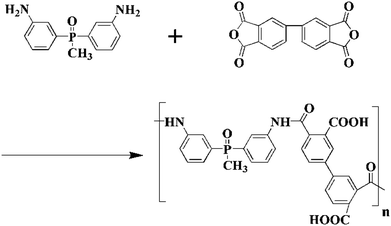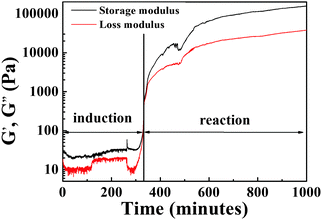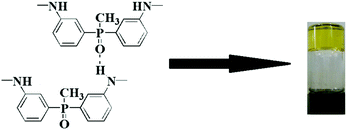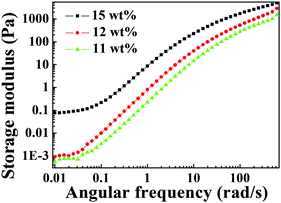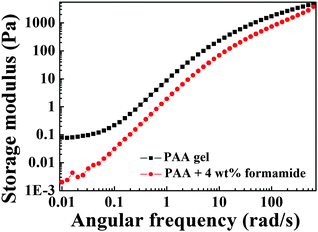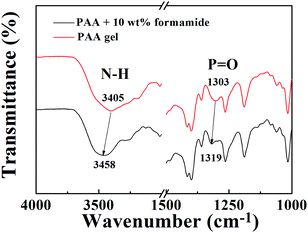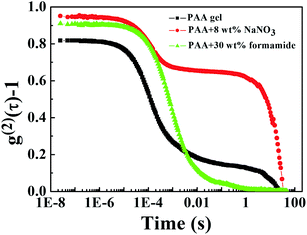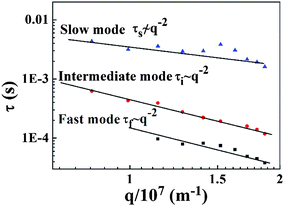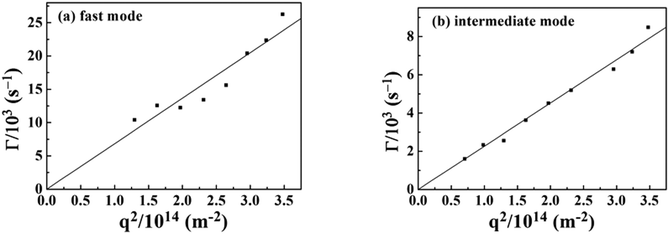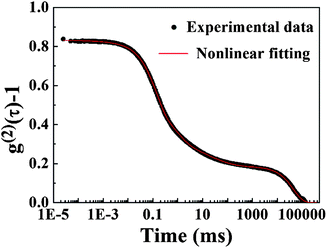Viscoelastic behaviour and relaxation modes of one polyamic acid organogel studied by rheometers and dynamic light scattering†
Ensong
Zhang
 a,
Yong
Zhao
b,
Wenke
Yang
a,
Hongxiang
Chen
a,
Wei
Liu
a,
Xuemin
Dai
b,
Xuepeng
Qiu
a,
Yong
Zhao
b,
Wenke
Yang
a,
Hongxiang
Chen
a,
Wei
Liu
a,
Xuemin
Dai
b,
Xuepeng
Qiu
 *b and
Xiangling
Ji
*b and
Xiangling
Ji
 *a
*a
aState Key Laboratory of Polymer Physics and Chemistry, Changchun Institute of Applied Chemistry, Chinese Academy of Sciences, Changchun 130022, People's Republic of China. E-mail: xlji@ciac.ac.cn; Fax: +86 431 85262075; Tel: +86 431 85262876
bLaboratory of Polymer Composites and Engineering, Changchun Institute of Applied Chemistry, Chinese Academy of Sciences, Changchun 130022, People's Republic of China. E-mail: xp_q@ciac.ac.cn; Fax: +86 431 85262095; Tel: +86 431 85262557
First published on 4th December 2017
Abstract
A novel polyamic acid (PAA from BAPMPO-BPDA) organogel was synthesized and characterized via dynamic light scattering (DLS), a classical rheometer, and diffusion wave spectroscopy (DWS). In situ monitoring was performed using a classical rheometer to observe the formation of the PAA organogel. The rheological curves confirm the formation of the PAA gel network and the origin of hydrogen bonding from the –NH– group (donor) and P![[double bond, length as m-dash]](https://www.rsc.org/images/entities/char_e001.gif) O group (acceptor). The autocorrelation functions of PAA under different conditions (pure gel, gel with NaNO3, gel with formamide) are measured via DLS, and different characteristic times are obtained via the CONTIN method. Three different relaxation modes of the PAA gel, i.e., fast, intermediate and slow modes, are observed. The fast and intermediate modes show a diffusive behaviour (τ ∼ q−2), whereas the slow mode did not. When enough formamide is added into the PAA gel, the fast mode disappears; addition of enough salt (NaNO3) leads to disappearance of the slow mode. The relationship between characteristic time and diffusion vector demonstrates that the different decorrelation modes consisted of two homodyne and two heterodyne components. Two single-exponential functions and two stretched exponential functions were used, and the different decorrelation modes of the PAA gel are expressed with a non-linear function, which fits the autocorrelation function very well. And the different decorrelation modes are also discussed. DWS results in the high-frequency region not only demonstrate the formation of a PAA gel network but also indicate that the semiflexible chains of PAA are due to electrostatic interaction. The DWS results at different time scales are analyzed by applying the de Gennes’ reptation model.
O group (acceptor). The autocorrelation functions of PAA under different conditions (pure gel, gel with NaNO3, gel with formamide) are measured via DLS, and different characteristic times are obtained via the CONTIN method. Three different relaxation modes of the PAA gel, i.e., fast, intermediate and slow modes, are observed. The fast and intermediate modes show a diffusive behaviour (τ ∼ q−2), whereas the slow mode did not. When enough formamide is added into the PAA gel, the fast mode disappears; addition of enough salt (NaNO3) leads to disappearance of the slow mode. The relationship between characteristic time and diffusion vector demonstrates that the different decorrelation modes consisted of two homodyne and two heterodyne components. Two single-exponential functions and two stretched exponential functions were used, and the different decorrelation modes of the PAA gel are expressed with a non-linear function, which fits the autocorrelation function very well. And the different decorrelation modes are also discussed. DWS results in the high-frequency region not only demonstrate the formation of a PAA gel network but also indicate that the semiflexible chains of PAA are due to electrostatic interaction. The DWS results at different time scales are analyzed by applying the de Gennes’ reptation model.
1. Introduction
Gels are defined as non-fluidic colloidal networks or polymer networks that are expanded throughout their whole volume by a fluid.1 Depending on their crosslinking system, gels can be divided into chemical gels (multi-functional group crosslink) and physical gels (physical interaction crosslink). For physical gels, various types of physical crosslinks exist, such as hydrogen bonds, dipole interaction, micellar formation of hydrophobic groups, and microcrystalline junctions.2 In recent years, physical gels made from noncovalent interaction have attracted much attention because of their unique responsive behaviour and functions (hydrogen bonding interaction,3 ionic interaction,4 and hydrophobic/hydrophilic interaction5). Physical gels have been applied in the food industry, drug delivery, musculoskeletal tissue engineering, molecular filters, anion sensors, and so on.6–11 For instance, Yan et al. proposed an alternative pathway for fabrication of a collagen protein hydrogel with shear-thinning and self-healing properties based on a biomineralization triggered process, which involves electrostatic complexation between positively charged collagen chains and inorganic anionic clusters.12 The resulting hydrogels exhibit advantages as an in vivo injectable material for biomedical applications.Gels are also classified as hydrogels (in water) or organogels (in organic solvent) depending on the medium used for fabrication. The mechanisms and applications of physical crosslinking hydrogels, especially hydrogen bond crosslinking, have been experimentally and theoretically studied. Meanwhile, organogels have attracted much attention because of their super-sensitivity to changes in their environment. Yao et al.13 synthesized a novel organogel whose colour changes from milky white to transparent with increasing temperature. Moreover, the contact angle also drastically decreases with increasing temperature. Garcia et al.14 designed a novel organogel via paraformaldehyde condensation with diamines, and the produced organogel showed high recyclability and strong thermoset abilities. However, compared with hydrogels, organogels are seldom reported in the literature.
Polyimides are one kind of advanced material that has been extensively investigated15–17 and can be applied in microelectronics, aerospace, and many areas as a type of resin, film, fiber, or foam.18–22 However, the precursor of polyimides, i.e., polyamic acid (PAA), has not been systematically studied because of its instability and its so-called “degradable” behaviour. Most studies have focused on the stability of PAA. Artem'eva et al.23 used three different structures of diamine to synthesize PAA and analyzed their intrinsic viscosity during storage at room temperature. The stability of polypyromellitamic acids in solution was determined by the length of the monomeric unit, i.e., by the content of weak o-carboxyamide units in a macromolecule. Cai et al.24 synthesized a novel PAA-ammonium salt, which has higher stability than that of PAA. The degradation of PAA has been suggested to be caused by acid-catalyzed hydrolysis in the amide group, and this process involves the intramolecular cyclization of the o-carboxyl groups onto the amide linkage with the elimination of the amine. When o-carboxyl groups in PAA are converted to amine salts, the reaction of acid-catalyzed hydrolysis is suppressed by the presence of amine salts. However, studies on the physical properties of concentrated PAA solution, especially for PAA gel, are limited.
In the present study, a PAA organogel was synthesized and its viscoelastic properties were investigated via classical rheometer, dynamic light scattering (DLS), and diffusion wave spectroscopy (DWS, also called microrheometer). The formation mechanism of a PAA organogel is also discussed. This study will be helpful to understand the origin of this kind of PAA gel and its viscoelastic behaviour.
2. Experimental section
2.1 Chemicals
The reactant bis(3-aminophenyl)methylphosphine oxide (BAPMPO), 4,4′-oxydianiline (4,4′-ODA) and 3,3′,4,4-biphenyl dianhydride (BPDA) were purchased from Beijing Multi Technology. The solvent N,N-dimethylacetamide (DMAc) was purchased from Beijing Multi Technology. Before preparation, all the monomers were purified by sublimation.2.2 Synthesis of PAA
In a 500 mL round-bottomed flask, 16.92 g (0.055 mol) BAPMPO was dissolved in 200 mL of DMAc (dried in the presence of P2O5 overnight), then 16.15 g (0.055 mol) BPDA was added and the reaction was carried out at 17 °C for 48 h under stirring and dry nitrogen flow. Scheme 1 shows the synthetic route of PAA. After the reaction was finished, the sample was sealed and stored at −18 °C in a refrigerator.2.3 Rheometer
All rheological measurements were carried out using a DHR-2 stress-controlled rheometer (TA Instruments), where a 40 mm, 2° cone and plate geometry was used. A temperature-controlled Peliter plate was used to control the temperature of the measurements. Before the experiment, all the samples were tested by oscillation amplitude to ensure the measurement was in the region of linear viscoelasticity. The oscillation frequency was varied from 10−2 to 102 rad s−1. In order to prevent the evaporation of solvent, two semicircle 60 mm iron plates were covered around the geometry, and silicone grease was filled around the gap of the iron plates.2.4 Dynamic light scattering
Dynamic light scattering (DLS) is an effective tool in probing different relaxation processes. Using the intensity correlation function | (1) |
 | (2) |
| |g(2)(q,τ)| = 1 + β[g(1)(q,τ)]2 | (3) |
|g(1)(q,τ)| = G![[thin space (1/6-em)]](https://www.rsc.org/images/entities/i_char_2009.gif) exp(−Γτ) exp(−Γτ) | (4) |
 | (5) |
| Γ = q2D | (6) |
The scattering field for nonergodic media, such as polymer gel, contains both time-dependent (homodyne) and time-independent (heterodyne) components. Hence, it can be expressed as:25
| E(t) = EF(t) + EC | (7) |
The time–intensity correlation function can be given by:26
| g(2)(τ) − 1 = X2[g(1)F(τ)]2 + 2X(1 − X)g(1)F(τ) | (8) |
 | (9) |
![[L with combining circumflex]](https://www.rsc.org/images/entities/i_char_004c_0302.gif) B(Γ)||2 is the regulation term, using 0 < a < 1 to determine the details of the solution of equation; B(Γ) is the distribution of decay rate. Finally, the CONTIN method was used to separate these components.
B(Γ)||2 is the regulation term, using 0 < a < 1 to determine the details of the solution of equation; B(Γ) is the distribution of decay rate. Finally, the CONTIN method was used to separate these components.
A commercial LLS spectrometer (ALV CGS-3) was equipped with a multi-τ digital time correlator (ALV7000) and a cylindrical 22 mW He–Ne laser (λ0 = 632.8 nm, Uniphase) as a light source (ALV-GmbH, Germany). The temperature of the scattering vial was controlled by a thermostatic water bath (JULABO F12-ED) with a temperature precision of 0.02 °C. Each temperature was kept for at least 10 min to reach equilibrium before measurements. A gel is a nonergodic system. In order to circumvent the nonergodicity, the sample cell was rotated steadily while time-averaging. All the measurements were kept at 20 °C for 30 min to get the correlation function precisely. The range of scattering angle θ was from 70° to 140°, with a step of 10°. The decay time distribution was obtained by using the CONTIN method of the experimental correlation function.
2.5 Diffusion wave spectroscopy
Diffusion wave spectroscopy extends the applications of traditional DLS. Based on strong multiple light scattering, for the transmission method, the g(1)(τ) was given by27 (for λ ≪ l* ≪ L, λ is the wavelength of light, L is the sample thickness, strong multiple light scattering is irrelevant of scattering vector): | (10) |
 | (11) |
γ is a constant which allows low-order scattering to be quantified, and a characterizes deviations from the idealized semi-infinite slab geometry. Taking the Laplace transform, the relation between ![[G with combining tilde]](https://www.rsc.org/images/entities/i_char_0047_0303.gif) (s) and 〈Δ
(s) and 〈Δ![[small gamma, Greek, tilde]](https://www.rsc.org/images/entities/i_char_e0dd.gif) 2(s)〉 can be written as28
2(s)〉 can be written as28
 | (12) |
![[G with combining tilde]](https://www.rsc.org/images/entities/i_char_0047_0303.gif) (s) is the viscoelastic spectrum; 〈Δ
(s) is the viscoelastic spectrum; 〈Δ![[small gamma, Greek, tilde]](https://www.rsc.org/images/entities/i_char_e0dd.gif) 2(s)〉 is the Laplace 〈Δr2(τ)〉; s is the Laplace frequency. And finally, using the unilateral Fourier transform, an expression for the viscoelastic modulus as a function of frequency can be obtained.
2(s)〉 is the Laplace 〈Δr2(τ)〉; s is the Laplace frequency. And finally, using the unilateral Fourier transform, an expression for the viscoelastic modulus as a function of frequency can be obtained. | (13) |
DWS experiments were performed on a DWS RheoLab II (LS Instrument) equipped with a single photon-counting avalanche photodiode (APD) as a detector and a linear correlator with the smallest sampling time of 12 ns. The coherent source was a diode laser with a wavelength of 687 nm and power of 40 mW.
Monodispersed SiO2 nanoparticles with a radius of 270 nm purchased from Bangs Laboratories were chosen as tracer particles. 0.5 g nanoparticles were poured into 1 mL of DMAc in a 10 mL conical flask, and the mixture was ultrasonicated for at least 20 min to obtain a homogeneous dispersion. The turbid solution was added into polyamic acid gel and stirred, and stored in a refrigerator for at least one day to remove the air bubbles completely.
The width of the sample cell holder was 10 mm and the temperature of measurement was 20 °C. Before measurement, the transport mean free path l* was measured by transmission scattering. However, the method of adding the tracer particle can dilute the polyamic acid gel and influence the result. Only a small amount of tracer particles was added in and makes the ratio L/l* = 5–6 (near the lower limit of the DWS experiment).
2.6 UV-visible spectroscopy
UV-visible spectra were recorded on a Shimadzu UV-2450 double-beam recording spectrophotometer using 1 cm quartz cells (Shimadzu Corporation, Japan). The as-prepared polyamic acid solution or gel exhibits a yellow colour, Fig. S1 (ESI†) is the UV-visible spectrum and the transmittance of polyamic acid gel at 633 nm was up to 94%, indicating almost no influence on both DLS and DWS measurements.2.7 FT-IR spectroscopy
Fourier transform infrared (FTIR) spectra were recorded on a Bruker Vertex 70 spectrometer at 64 scans with a resolution of 2 cm−1 for polyamic acid solution (Bruker Corporation).3. Results and discussion
3.1 PAA organogel
The BAPMPO-BPDA PAA in DMAc lost its mobility, which can be seen clearly in Fig. 1a. In a macroscopic sense, it indicates that the gel had been formed. Excessive solvent cannot dissolve the PAA gel (see Fig. S2, ESI†). Formamide is often applied to break the hydrogen bonds in solution. In this study, a small amount of formamide (2 wt%) and excessive DMAc as a solvent were added to the PAA gel and then stirred. As shown in Fig. 1b, the original PAA gel became transparent. This result demonstrates that the formation of hydrogen bonds results in aggregation of the PAA chains to form a gel.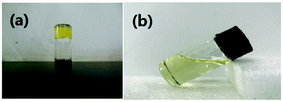 | ||
| Fig. 1 Pictures taken in indoor day-time, (a) PAA gel (15 wt% in DMAc), (b) PAA gel with 2 wt% formamide and excessive solvent DMAc. | ||
3.2 Formation mechanism of the gel from a classical rheometer
![[double bond, length as m-dash]](https://www.rsc.org/images/entities/char_e001.gif) O, C
O, C![[double bond, length as m-dash]](https://www.rsc.org/images/entities/char_e001.gif) O, or CO–O− group. To confirm the identity of the acceptor, another diamine, 4,4′- oxydianiline (4,4′-ODA), was chosen and different contents of 4,4′-ODA and BAPMPO were copolymerized with BPDA (shown as Scheme 2).
O, or CO–O− group. To confirm the identity of the acceptor, another diamine, 4,4′- oxydianiline (4,4′-ODA), was chosen and different contents of 4,4′-ODA and BAPMPO were copolymerized with BPDA (shown as Scheme 2).
As shown in Fig. 3, in the low-angular frequency region, the storage modulus of PAA without BAPMPO (i.e., ODA-BPDA) grows linearly as the frequency increases. When the ratio of BAPMPO was increased, the slope of the storage modulus decreased in the low-frequency range. The storage modulus plateaued when the ratio of BAPMPO was above 70%. This result indicates the elasticity of the PAA gel in the low-frequency range. Similar to the 100% BAPMPO PAA gel, the 70% BAPMPO PAA gel cannot be dissolved by DMAc.
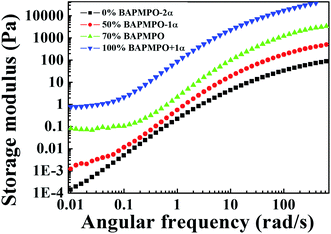 | ||
| Fig. 3 Storage modulus of 15 wt% PAA with different amounts of diamine (BAPMPO:4,4′-ODA) as a function of angular frequency. In order to make the curve clearer, some are moved by α (1 decade). | ||
An ideal gel has an almost pure elastic response behaviour. The elastic modulus should be much higher than the viscous modulus and is independent of frequency. However, when gel networks are formed with imperfections, the response of the polymer gel depends on frequency, i.e., both the storage and loss moduli increase with frequency. The polymer gel can be tested at various time scales by using the oscillation mode in rheological experiments. At low frequencies, both the gel and polymer sol are rearranging because of the Brownian motion. Thus, the measured properties are dominated by the elastic deformation equilibrium of the gel network. As shown in Fig. 3, when the frequency approaches zero, the elastic modulus approaches a constant value, known as the equilibrium modulus of the gel network.
Physical entanglements are created and broken quickly at low frequencies. Thus, they do not contribute drag or store elastic energy. At intermediate frequencies, both the polymer sol and the polymer chain segment between two physical crosslink points begin to relax. Thus, the storage and loss moduli obey the Maxwellian behaviour. At high frequencies, physical entanglements persist longer than oscillation frequency. Thus, the entanglements physically constrain the polymers, store elastic energy, and contribute to viscous dissipation.29 In the present study, the plateau behaviour of the storage modulus in the low frequency range indicates the appearance of the PAA gel, and the hydrogen bonding originates from the –NH– group (donor) and P![[double bond, length as m-dash]](https://www.rsc.org/images/entities/char_e001.gif) O group (acceptor), as illustrated in Fig. 4.
O group (acceptor), as illustrated in Fig. 4.
Even though the weight percentage of BAPMPO-BPDA decreases to 11 wt%, the plateau of the storage modulus in the low-angular frequency range was still observed, as shown in Fig. 5. More solvent was added into the 11 wt% PAA gel, but the gel cannot absorb excessive solvent, which is consistent with the result in Fig. S2 (ESI†).
The FT-IR spectra also demonstrate that the hydrogen bonds cause the formation of the gel structure. The shift of absorption peak can reflect the variation of the system.30 As Fig. 7 shows, in the PAA gel, the peak at 3405 cm−1 is assigned to the stretching vibration of N–H, and the peak at 1303 cm−1 is assigned to the stretching vibration of P![[double bond, length as m-dash]](https://www.rsc.org/images/entities/char_e001.gif) O. When 10 wt% formamide was added to the gel (to break the hydrogen bonds), the stretching vibration of N–H moves to 3458 cm−1, i.e. the hydrogen bonds exchange between N–H and formamide, which makes the peak shift to a high wavenumber, meanwhile that of P
O. When 10 wt% formamide was added to the gel (to break the hydrogen bonds), the stretching vibration of N–H moves to 3458 cm−1, i.e. the hydrogen bonds exchange between N–H and formamide, which makes the peak shift to a high wavenumber, meanwhile that of P![[double bond, length as m-dash]](https://www.rsc.org/images/entities/char_e001.gif) O shifts to 1319 cm−1. These results indicate that hydrogen bonds exist between P
O shifts to 1319 cm−1. These results indicate that hydrogen bonds exist between P![[double bond, length as m-dash]](https://www.rsc.org/images/entities/char_e001.gif) O and N–H groups.
O and N–H groups.
3.3 Relaxation modes from DLS results
 | ||
| Fig. 9 CONTIN results of PAA under different conditions. (a) PAA gel, (b) PAA + 8 wt% NaNO3, (c) PAA + 30 wt% formamide. The scattering angle is 90°. | ||
To discuss the autocorrelation function with several decorrelation modes, a combination of several stretched exponential functions should be used to fit the correlation function:31,32
g(2)(τ) − 1 = σI2(A1![[thin space (1/6-em)]](https://www.rsc.org/images/entities/char_2009.gif) exp(−Γ1τ)δ1 + A2 exp(−Γ1τ)δ1 + A2![[thin space (1/6-em)]](https://www.rsc.org/images/entities/char_2009.gif) exp(−Γ2τ)δ2+…) exp(−Γ2τ)δ2+…) | (14) |
The characteristic line width (Γ = 1/τ) versus the square scattering vector (q2) is plotted in Fig. 11. The relationship between fast mode, intermediate mode and scattering vector are a linear function of q2, and the line passes through the origin, which indicates that these two modes are diffusive control.33
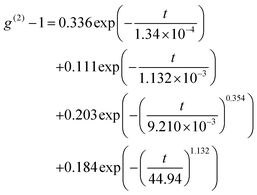 | (15) |
Compared with the CONTIN results of the pure PAA gel, the slow mode for PAA with 8 wt% NaNO3 disappears. Moreover, in Fig. 10, the slow mode τsversus scattering vector q does not show diffusive behaviour, which reflects the nonergodic behaviour. Thus, the electrostatic interaction causes the agglomeration of PAA chain segments (crosslink) and is the origin of the nonergodic slow mode. (The variation of the plateau MSD from the DWS results also demonstrates this. Isolating the electrostatic interaction enlarges the size of the gel network, which makes the escape of the tracer particles from the network much easier. And the time of cut-off of the plateau becomes much shorter, as shown in Fig. 13.) Both the fast mode τf and the intermediate mode τi obey the diffusion rule. Owing to the appearance of the hydrogen bonding crosslinking point in the PAA gel network, the diffusion of PAA chain segments between crosslinking points is different in different directions. Thus, the origin of the fast mode τf and the intermediate mode τi is the movement of PAA chain segments in different directions.
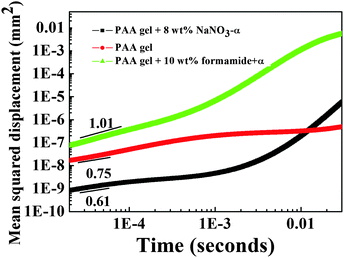 | ||
| Fig. 13 Mean squared displacement as a function of time for PAA (15 wt%) under different conditions. In order to observe the curves clearly, some curves are moved by α (1 decade). | ||
Wu et al.33 synthesized a novel polymer that can change from being charged to neutral by formation of different gases (bubbles). They found that the neutral polymer only had one decorrelation mode, but when it became charged, the sole decorrelation mode was split into two modes, namely, fast and slow. Both of them obey the diffusion rule, and the coupling of the diffusion of the chains and the fluctuation of chain segments nearby the counterions account for the results mentioned earlier. For PAA with 30 wt% formamide, due to the breakage of the PAA network and the appearance of –COOH and –NH– groups, the solution behaviour can be regarded as a concentrated charged polymer solution. Thus, the origin of the two modes is similar to Wu's results.33
3.4 Viscoelastic behaviour from DWS results
Above 100 rad s−1, the classical rheometer cannot be used to determine the storage and loss moduli precisely because of inertia and instrument limitation. Although time–temperature superposition can be applied to obtain precise information in extremely low- and high-angular frequency ranges, the PAA gel cannot be detected in the high-frequency range because of two reasons: the PAA gel degrades very fast when the temperature is above 40 °C,34 and water vapour condenses on the Peliter plate at temperatures below 15 °C. These problems can be avoided in the DWS experiments, and information about the PAA gel at high-frequency regions can be obtained.The non-affinity of the gel network is considered, and interaction (depletion, absorption, and so on) between tracer particles and the gel network possibly exists.35 The result of the DWS experiment cannot fit those from a classical rheometer. Thus, only the behaviour of the PAA gel in the high-frequency region was qualitatively discussed.
Fig. 13 shows the mean squared displacement (MSD) as a function of time in the backscattering geometry. The relationship between MSD and time (〈Δr2(τ)〉 ∼ τα) can reflect the property of the medium.36 When the time is short, the tracer particle is trapped in the network of the polymer and cannot “escape” from the network. Given that the tracer particles are confined in the PAA network and cannot move further than the size of the network, a constant value of MSD was observed. We divided the time into two scales and discussed them separately.
For the PAA gel with salt, when the time scale is longer than the intermediate characteristic time τi, the MSD increases. Thus, the trapped tracer particle “escaped” from the network of the PAA gel. For pure PAA gel, the same phenomenon occurs on a time scale longer than the slow characteristic time τs, but the relationship between MSD and time in a prolonged time scale was not determined because of measurement limits.
![[thin space (1/6-em)]](https://www.rsc.org/images/entities/char_2009.gif) 000 rad s−1), which is consistent with the characteristics of semi-flexible chains.41
000 rad s−1), which is consistent with the characteristics of semi-flexible chains.41
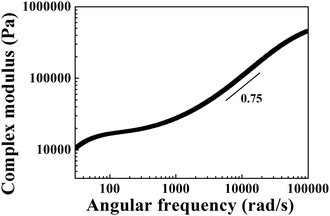 | ||
| Fig. 14 The complex modulus as a function of angular frequency measured with DWS for the PAA gel (15 wt%). | ||
The results in Fig. 14 can also be transformed into the storage and loss moduli as a function of angular frequency, as shown in Fig. 15. By applying the de Gennes’ reptation model,42 the results of DWS can be divided into different time scales: reptation time τrep, Rouse time of the chain τR, Rouse time of an entanglement strand τe, and the monomer motion time τ0.42τrep, τe, and τ0 can be obtained from the three intersections between G′ and G′′, and τR can be calculated from the relationship between these variables.43
 | (16) |
 | (17) |
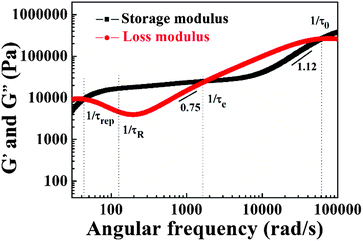 | ||
| Fig. 15 The storage modulus and the loss modulus as a function of angular frequency measured with DWS for the PAA gel (15 wt%). | ||
The power law between G′, G′′, and angular frequency at the high-frequency region can be used to confirm the results. For the Rouse model, the exponent is 1/2 and that of the Zimm model is 2/3.44 However, between 600 rad s−1 and 1/τe, for the PAA gel, the power law between the loss modulus and angular frequency is G′′ ∼ ω0.75 because the electrostatic interaction stretches the polymer chains, thereby deviating from the Rouse and Zimm model. The results are in accordance with the theory of internal bending modes for single Kuhn segments.40 Nevertheless, between 20![[thin space (1/6-em)]](https://www.rsc.org/images/entities/char_2009.gif) 000 rad s−1 and 1/τ0, the power law between storage modulus and angular frequency does not match the theoretical value. Willenbacher et al. reported the scaling relationship G′′ ∼ ω0.75 for ω > 104 rad s−1 and indicated the onset of G′ ∼ ω0.75 for ω > 5 × 105 rad s−1 for worm-like micelle solutions.45 However, the inertia of tracer particles influences the result in the extremely high-angular frequency range. Moreover, 5 × 105 rad s−1 is beyond the measurement range of the current DWS instrument. The ω0.75 scaling was also not solved by Buchanan et al.46 because their experiments were limited to frequencies below 105 rad s−1, which is similar to the present case. Thus, G′ at extremely high angular frequencies cannot be obtained.
000 rad s−1 and 1/τ0, the power law between storage modulus and angular frequency does not match the theoretical value. Willenbacher et al. reported the scaling relationship G′′ ∼ ω0.75 for ω > 104 rad s−1 and indicated the onset of G′ ∼ ω0.75 for ω > 5 × 105 rad s−1 for worm-like micelle solutions.45 However, the inertia of tracer particles influences the result in the extremely high-angular frequency range. Moreover, 5 × 105 rad s−1 is beyond the measurement range of the current DWS instrument. The ω0.75 scaling was also not solved by Buchanan et al.46 because their experiments were limited to frequencies below 105 rad s−1, which is similar to the present case. Thus, G′ at extremely high angular frequencies cannot be obtained.
4. Conclusions
A novel PAA organogel was synthesized and characterized via classical rheometer, dynamic light scattering, diffusion wave spectroscopy, and FTIR spectroscopy. The main results are summarized as follows.(i) In situ monitoring results via classical rheometer and FTIR spectroscopy confirm that when the length of the PAA chains grows to a certain length, the hydrogen bonds between P![[double bond, length as m-dash]](https://www.rsc.org/images/entities/char_e001.gif) O and N–H groups induce the formation of a PAA gel network. Such a PAA gel network can be destroyed by adding formamide.
O and N–H groups induce the formation of a PAA gel network. Such a PAA gel network can be destroyed by adding formamide.
(ii) In the DLS experiments, three different relaxation modes of the PAA gel, i.e., fast, intermediate and slow modes, are observed. The fast and intermediate mode shows a diffusive behaviour (τ ∼ q−2), whereas the slow mode did not. When enough formamide is added into the PAA gel, the fast mode disappears. However, when enough salt (NaNO3) is added into the PAA gel, the slow mode disappears. The origin of different modes is determined: the fast mode and the intermediate mode come from the movement of PAA chain segments between a crosslinking point in different directions, and the slow mode is the agglomeration of PAA chain segments due to electrostatic interaction. Two single-exponential functions and two stretched exponential functions were used to express the different decorrelation modes with a nonlinear function. The results fit the autocorrelation function very well.
(iii) Based on the DWS experiments, the relationship between MSD and time is determined under different conditions, and electrostatic interaction causes the PAA chains to be stretched and become semi-flexible. By applying the de Gennes’ reptation model, the DWS result was divided into different time scales. The power law of the loss modulus and angular frequency fits the theory of the internal bending modes for single Kuhn segments (G′′ ∼ ω0.75).
Conflicts of interest
There are no conflicts to declare.Acknowledgements
We are grateful to the financial support from the National Basic Research Program of China (2014CB643604) and the National Natural Science Foundation of China (51173178). We appreciate the help of Prof. Quan Chen for his valuable suggestion on rheological data.References
- G. J. Richard, K. Jaroslav, S. Robert, S. W. Edward, H. Michael, K. Tatsuki and W. V. Metanomski, Compendium of Polymer Terminology and Nomenclature, 2nd edn, Royal Society of Chemistry, 2009 Search PubMed.
- F. Tanaka, Polymer Physics: Applications to Molecular Association and Thermoreversible Gelation, Cambridge University, 2011 Search PubMed.
- K. Haraguchi and T. Takehisa, Adv. Mater., 2002, 14, 1120–1124 CrossRef CAS.
- K. J. Henderson, T. C. Zhou, K. J. Otim and K. R. Shull, Macromolecules, 2010, 43, 6193–6201 CrossRef CAS.
- G. Miquelard-Garnier, S. Demoures, C. Creton and D. Hourdet, Macromolecules, 2006, 39, 8128–8139 CrossRef CAS.
- J. K. Oh, R. Drumright, D. J. Siegwart and K. Matyjaszewski, Prog. Polym. Sci., 2008, 33, 448–476 CrossRef CAS.
- Y. Tanaka, J. P. Gong and Y. Osada, Prog. Polym. Sci., 2005, 30, 1–9 CrossRef CAS.
- S. Varghese and J. H. Elisseeff, Adv. Polym. Sci., 2006, 203, 95–144 CrossRef CAS.
- G. Tummala, T. Joffre, R. Rojas, C. Persson and A. Mihranyan, Soft Matter, 2017, 13, 3936–3945 RSC.
- N. Malviya, M. Das, P. Mandal and S. Mukhopadhyay, Soft Matter, 2017, 13, 6243–6249 RSC.
- H. Guo, T. Jiao, Q. Zhang, W. Guo, Q. Peng and X. Yan, Nanoscale Res. Lett., 2015, 10, 272 CrossRef PubMed.
- R. Xing, K. Liu, T. Jiao, N. Zhang, K. Ma, R. Zhang, Q. Zou, G. Ma and X. Yan, Adv. Mater., 2016, 28, 3669–3676 CrossRef CAS PubMed.
- X. Yao, J. Ju, S. Yang, J. Wang and L. Jiang, Adv. Mater., 2014, 26, 1895–1900 CrossRef CAS PubMed.
- J. M. Garcia, G. O. Jones, K. Virwani, B. D. McCloskey, D. J. Boday, G. M. Huurne, H. W. Horn, D. J. Coady, A. M. Bintaleb, A. M. S. Alabdulrahman, F. Alsewailem, H. A. A. Almegren and J. L. Hedrick, Science, 2014, 344, 732–735 CrossRef CAS PubMed.
- M. Ding, Prog. Polym. Sci., 2007, 32, 623–668 CrossRef CAS.
- E. Zhang, X. Dai, Z. Dong, X. Qiu and X. Ji, Polymer, 2016, 84, 275–285 CrossRef CAS.
- E. Zhang, H. Chen, X. Dai, X. Liu, W. Yang, W. Liu, Z. Dong, X. Qiu and X. Ji, J. Polym. Res., 2017, 24, 47 CrossRef.
- A. Takuma and K. Hiroyoshi, Polymer, 2012, 53, 2217–2222 CrossRef.
- C. Zhang, Q. Zhang, Y. Xue, G. Li, F. Liu, X. Qiu, X. Ji and L. Gao, Chem. Res. Chin. Univ., 2014, 30, 163–167 CrossRef.
- R. Lei, L. Gao, R. Jin and X. Qiu, Chin. J. Polym. Sci., 2014, 32, 941–952 CrossRef CAS.
- B. Li, Y. Pang, C. Fang, J. Gao, X. Wang, C. Zhang and X. Liu, J. Appl. Sci., 2014, 131, 40498 Search PubMed.
- Y. Zhao, G. Li, X. Dai, F. Liu, Z. Dong and X. Qiu, Chin. J. Polym. Sci., 2016, 34, 1469–1478 CrossRef CAS.
- V. N. Artem'eva, V. V. Kudryavtsev, E. M. Nekrasova, V. P. Sklizova, N. G. Belnikevich, L. M. Kaluzhnaya, I. G. Silinskaya, O. P. Shkurko and V. P. Borovik, Russ. Chem. Bull., 1993, 42, 1673–1676 CrossRef.
- D. Cai, J. Su, M. Huang, Y. Liu, J. Wang and L. Dai, Polym. Degr. Stab., 2011, 96, 2174–2180 CAS.
- T. Norisuye, Q. Tran-Cong-Miyata and M. Shibayama, Macromolecules, 2004, 37, 2944–2953 CrossRef CAS.
- J. C. Mccoy and M. Muthukumar, J. Polym. Sci., Part B: Polym. Phys., 2010, 48, 2193–2206 CrossRef CAS.
- D. A. Weitz and D. J. Pine, Dynamic Light Scattering, Oxford University Press, 1993 Search PubMed.
- T. G. Mason, G. Hu and D. A. Weitz, J. Opt. Soc. Am. A, 1997, 14, 139–149 CrossRef CAS.
- J. D. Vicente, Rheology, 1st edn, InTech Publish, 2012 Search PubMed.
- R. Xing, W. Wang, T. Jiao, K. Ma, Q. Zhang, W. Hong, H. Qiu, J. Zhou, L. Zhang and Q. Peng, ACS Sustainable Chem. Eng., 2017, 5, 4948–4956 CrossRef CAS.
- T. Hiroi, M. Ohl, T. Sakai and M. Shibayama, Macromolecules, 2014, 47, 763–770 CrossRef CAS.
- J. Li, T. Ngai and C. Wu, Polym. J., 2010, 42, 609–625 CrossRef CAS.
- K. Zhou, J. Li, Y. Lu, G. Zhang, Z. Xie and C. Wu, Macromolecules, 2009, 42, 7146–7154 CrossRef CAS.
- E. Zhang, X. Dai, X. Liu, W. Yang, W. Liu, Z. Dong, X. Qiu and X. Ji, Acta Polym. Sin., 2017, 9, 1497–1505 Search PubMed.
- B. R. Dasgupta and D. A. Weitz, Phys. Rev. E: Stat., Nonlinear, Soft Matter Phys., 2005, 71, 021504 CrossRef PubMed.
- R. R. Vincent and M. A. K. Williams, Carbohydr. Res., 2009, 344, 1863–1871 CrossRef CAS PubMed.
- D. C. Morse, Macromolecules, 1998, 31, 7044–7067 CrossRef CAS.
- P. E. Rouse and K. Sittel, J. Appl. Phys., 1953, 24, 690–696 CrossRef CAS.
- J. Galvan-Miyoshi, J. Delgado and R. Castillo, Eur. Phys. J. E: Soft Matter Biol. Phys., 2008, 26, 369–377 CrossRef CAS PubMed.
- C. J. Kloxin and J. H. V. Zanten, J. Chem. Phys., 2009, 131, 134904 CrossRef PubMed.
- F. Gittes and F. C. MacKintosh, Phys. Rev. E: Stat. Phys., Plasmas, Fluids, Relat. Interdiscip. Top., 1998, 58, 1241–1244 CrossRef.
- P. G. de Gennes, Scaling Concepts in Polymer Physics, Cornell University Press, 1979 Search PubMed.
- M. Rubinstein and R. H. Colby, Polymer Physics, 3rd edn, Clarendon Press, Oxford, 2003 Search PubMed.
- M. Doi and S. F. Edwards, The Theory of Polymer Dynamics, Clarendon Press, Oxford, 1986 Search PubMed.
- N. Willenbacher, C. Oelschlaeger, M. Schopferer, P. Fischer, F. Cardinaux and F. Scheffold, Phys. Rev. Lett., 2007, 99, 068302 CrossRef CAS PubMed.
- M. Buchanan, M. Atakhorrami, J. F. Palierne, F. C. MacKintosh and C. F. Schmidt, Phys. Rev. E: Stat., Nonlinear, Soft Matter Phys., 2005, 72, 011504 CrossRef CAS PubMed.
Footnote |
| † Electronic supplementary information (ESI) available. See DOI: 10.1039/c7sm02185b |
| This journal is © The Royal Society of Chemistry 2018 |

